Tolkien explains why the Fellowship didn't fly the Eagles to Mordor in LEGO
On This Day - June 24, 1571 - Miguel Lopez de Legazpi proclaimed Manila as the capital of the Spanish colonial administration in the Philippines
June 24, 1571 Miguel Lopez de Legazpi proclaimed Manila as the capital of the Spanish colonial administration in the Philippines.
On June 24, 1571, Manila was proclaimed the capital of the Spanish colonial administration in the Philippines.
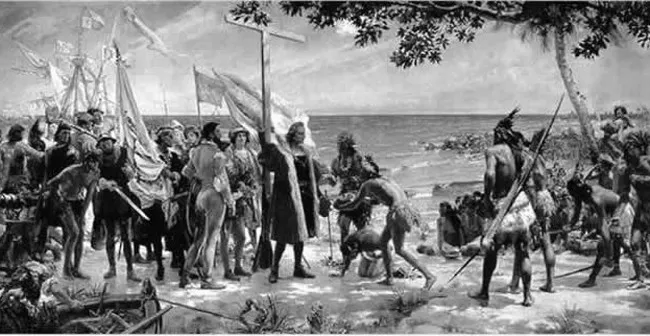
Earlier in Cebu, Spanish colonizer Miguel Lopez de Legazpi, having heard of the rich resources of Manila, dispatched two of his lieutenant-commanders, Martín de Goiti and Juan de Salcedo, to explore the northern region.
On May 8, 1570, they arrived in Manila and were welcomed by natives and formed an alliance with Rajah Sulayman, a Muslim king who ruled the place at that time. However, the local sensed the true objectives of the Spaniards and a battle between the troops of Sulayman and the Spaniards erupted. As the Spaniards were heavily armed, they were able to conquer Manila.
After hearing that the city had been conquered, Legazpi came to join Goiti in Manila. He formed a peace pact with the native councils, Rajah Sulayman and Rajah Lakandula.
On June 24, 1571, Legazpi finally established a permanent settlement, and he also ordered the construction of the walled city of Intramuros. He proclaimed Manila as the island's capital and permanent seat of the Spanish colonial government in the western Pacific Ocean.
Manila became a replica of a European medieval city. There were churches, palaces and city hall built in the Spanish baroque style. In 1574, Manila was bestowed the title "Insigne y Siempre leal Ciudad de España" (Distinguished and ever loyal city of Spain) by King Philip II.
By the end of the 16th century, Manila had become a leading commercial center of East Asia, carrying on a flourishing trade with China, India, and the East Indies.
Reference: Philippines News Agency archives
On this Day - June 23, 1898 - Emilio Aguinaldo established The Revolutionary Government of the Philippines
On this Day - June 23, 1898 - Emilio Aguinaldo established The Revolutionary Government of the Philippines in the Spanish East Indies during the Spanish–American War. The government succeeded a dictatorial government which had been established by Aguinaldo on June 18, and which was dissolved and replaced by this government upon its establishment.
The Revolutionary Government of the Philippines was an revolutionary government established in the Spanish East Indies on June 23, 1898, during the Spanish–American War, by Emilio Aguinaldo, its initial and only President.
The government succeeded a dictatorial government which had been established by Aguinaldo on June 18, and which was dissolved and replaced by this government upon its establishment.
This government endured until January 23, 1899, when the proclamation of the Malolos Constitution established an insurgent Philippine Republic government which replaced it.
Four governmental departments were initially created, each having several bureaus: foreign relations, marine and commerce; war and public works; police, justice, instruction and hygiene; finance, agriculture, and industry.
On This Day - June 22, 1920, Jovito Salonga was born in Pasig
On June 22, 1920, Jovito Salonga, a lawyer and legal scholar, educator and a distinguesed senator, was born in poverty in the present day Pasig City to a Presbyterian pastor, Esteban Salonga and Bernardita Reyes a market vendor. Jovito Salonga, the youngest of five brothers, worked his way through college and law school as a proofreader in the publishing firm of his eldest brother, Isayas.
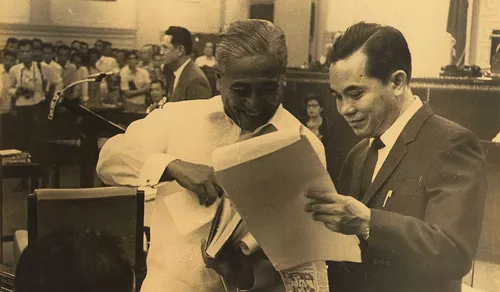
Salonga's long life began after the onset of American rule in the Philippines. His youth was a time of national hope and longing for independence. These things shaped him, alongside his family's deep Christian convictions and the hardships of their daily life. When he was twelve, a speech by the then House Speaker Manuel Roxas in his hometown stirred him to dream of a life in law and in public life.
Seizing on this ambition, he rose through public schools to the College of Law at the University of the Philippines. When war overtook his studies, Salonga quickly ran afoul of the new Japanese authorities. He was tortured and jailed and released after nearly a year. Amid dearth and uncertainty, he crammed for the bar examinations and, in 1944, earned the highest score.
At war's end, Salonga embraced Philippine independence but denounced "parity rights" and other compromising ties to the United States. He topped off his legal education with graduate degrees from Harvard and Yale universities and then plunged headlong into the life of his new nation.
Salonga established himself as a sought-after lawyer and an influential legal scholar and educator. In 1961, the Liberal Party tapped him for a successful run for Congress in his home province of Rizal. Four years later, he outpolled all other candidates for the Senate, a feat he repeated twice. He built his reputation as a crusader for clean government and public education. As a staunch nationalist, he opposed Philippine complicity in the Vietnam War and other acts of "puppetry." And he so persistently exposed the troubling anomalies of President Ferdinand Marcos that the Philippines Free Press named him the "Nation's Fiscalizer."
The bomb that crippled him at a political rally in 1971, Salonga says, led him to a second, "borrowed life". He opposed martial law from the start, defending opponents of the Marcos dictatorship and working tirelessly for the succor and release of political prisoners and for the democratic opposition. In 1980, he himself was jailed without charges and then released. Four years in exile followed.
Yet Salonga never lost hope. In 1985, he returned home to revitalize his political party and confront the dictatorship. Putting aside personal ambition, he withdrew his candidacy for vice president in the snap elections of February 1986 and threw himself heart-and-soul into Corazon Aquino's presidential campaign and the People Power Revolution.
Afterwards, Salonga initiated the new government's legal efforts to reclaim wealth allegedly stolen by the Marcoses as chairman of the Presidential Commission on Good Government. In 1987, voters returned him to the Senate. There, he authored new laws protecting the state from plunder, military coups, and corrupt officials and, in 1991 as Senate president, triumphantly led his colleagues in ejecting American military bases from the Philippines.
Salonga returned to private life the following year, having made a hotly contested but disappointing bid for the presidency. But through his NGOs, Bantay Katarungan (Sentinel of Justice) and Kilos Bayan (People's Action), he has sustained his principled interventions in the affairs of the nation.
Jovito Salonga was awarded the 2007 Ramon Magsaysay Award for Government Service for his exemplary integrity and substance of his long public career in service to democracy and good government in the Philippines.
Senator Salonga died on Thursday, March 10, 2016. He was 95 years old.
References
- Ramon Magsaysay Award Foundation
- Wikipedia
On This Day - June 21, 1884 - Jose P. Rizal completed his medical course in Madrid, Spain, with the rating “Fair”
On This Day - June 21, 1884 - Jose P. Rizal completed his medical course in Madrid, Spain, with the rating “Fair”
He was awarded the degree of Licentiate in Medicine by the Universidad Central de Madrid. The next academic year (1884–1885) he studied and passed all subjects leading to the degree of Doctor of Medicine. “Due to the fact, however, that he did not pay the corresponding fees, he was not awarded his Doctor’s diploma”*
Rizal also finished his studies in Philosophy and Letters, with higher grades. He was awarded the degree of Licentiate in Philosophy and Letters by the Universidad Central de Madrid on June 19, 1885 (his 24th birthday), with the rating of “Excellent with a scholarship.”
At long last, Rizal completed his studies in both Medicine and Philosophy and Letters. He was ready then to face the world and lead the fight for his country’s redemption. He was determined to see more of Europe before returning home, and acquire more medical lore in the clinics of Europe’s eminent physicians.
As to recall, Rizal, found the atmosphere at the University of Santo Tomas suffocating to his sensitive spirit. He was unhappy at this Dominican institution of high learning because (1) the Dominican professors were hostile to him, (2) the Filipino students were racially discriminated, and (3) the method of instruction was obsolete and repressive.
In his novel, El Filibusterismo, he described how the Filipino students were humiliated and insulted by their Dominican professors and how backward was the method of instruction, especially in the teaching of natural sciences. He related in Chapter XIII of this novel, entitled “The Class in Physics,” that this science subject was taught without laboratory experiments. The microscope and other laboratory apparatus were kept inside the showcases to be seen by visitors, but the students could not even touch them.
After finishing the fourth year of his medical course at the University of Santo Tomas, Rizal decided to study in Spain. At that time, he could no longer endure the rampant bigotry, discrimination, and hostility in that school. His uncle, Antonio Rivera, Leonor Rivera’s father, encouraged him to go abroad. Both Paciano and Saturnina, whom he contacted secretly, were of similar opinion.
For the first time, Rizal did not seek his parents’ permission to go abroad, because he knew that they, especially his mother, would disapprove his plan. Thus, the Spanish authorities knew nothing of his decision to go abroad in order to finish his medical studies in Spain, where the professors were more tolerant and understanding than those of the University of Santo Tomas.
Later on, Rizal then asked his parents’ blessings and unknown to the Spanish authorities, Rizal left Manila on May 3, 1882. Rizal’s departure for Spain was kept secret in order to avoid detection by the colonial officials and the friars. Only Uncle Antonio Rivera, Paciano, and his sisters, and some close friends knew that Rizal would leave for Spain. Paciano gave him 700 pesos. Saturnina later gave him a diamond ring, which helped him very much during his days of poverty in Europe.
He went to Spain where he completed his university studies, improved his knowledge of languages and arts, and further developed his God-given talents for greater service to the fatherland. At that time, the government in Spain was a constitutional monarchy, under which the Spanish people enjoyed individual liberties, including freedom of speech and freedom of the press.
On November 3, 1882, Rizal enrolled in the Universidad Central de Madrid in two courses – Medicine and Philosophy and Letters. Aside from his heavy studies in the university, he studied painting and sculpture in the Academy of San Carlos, took lessons in French, German, and English under a private instructor and assiduously practiced fencing and shooting in the Hall of Arms of Sanz y Carbonell. His thirst for knowledge was unlimited. He attended operas and concerts to improve his knowledge of music; he visited the art galleries and museums and read books on all subjects under the sun, including military engineering, in order to broaden his cultural background.
He strictly budgeted his money and time. He lived frugally and never wasted time. His spare hours were devoted to attending lectures, operas, religious fiestas; and reading at home or at the libraries. A favorite pastime of Rizal in Madrid was reading. He stayed at home and read voraciously until midnight. Since early childhood, he liked to read. Due to lack of funds, several times Rizal earned little money by working as a private tutor to rich students.
After completing his studies in Madrid, Rizal went to Paris and Germany in order to specialize in ophthalmology. He particularly chose this branch of medicine because he wanted to cure his mother’s eye. When Rizal returned to the Philippines, he established a medical clinic in Calamba. His first exploit as a physician in his land was the successful operation on his mother’s sightless eyes. With surgical skill acquired in the best eye clinics in Europe, he removed a double cataract from Doña Teodora’s eyes. News of the successful operation spread far and wide. To the masses, the restoration of the sight of Rizal’s mother was a miracle. Patients from Manila and the provinces flocked to Calamba. Rizal, who came to be called “Doctor Uliman” because he came from Germany, was busy attending to his lucrative medical practice. His professional fees were reasonable, even gratis to the poor.
Sources and References:
1. Gregorio F. Zaide, Jose Rizal, Life, Works, and Writings, Far Eastern University, Department of History, 1957, pp. 53–54, 66–67, 102
2. Gregorio F. Zaide, Sonia M. Zaide, History of the Republic of the Philippines, Metro Manila, 1983, 1987, p. 219
*Dr. Jose F. Bantug, “Rizal, The Physician,” The Journal of History, Manila Vol. V, Nos. 1–3, p. 49
On This Day - June 20, 1899 - Japanese vessel Nonubiki Maru left Nagasaki for the Philippines loaded with war supplies purchased by Mariano Ponce
On June 20, 1899, the Japanese vessel Nonubiki Maru left Nagasaki for the Philippines loaded with 10,000 rifles, 6,000,000 rounds of ammunition, and other war supplies purchased by Mariano Ponce.
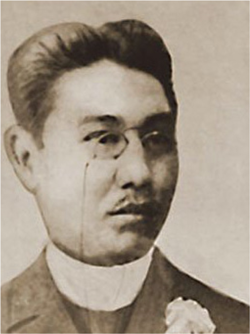
|
|
| (Mariano Ponce) |
Ponce with the aid of the Chinese revolutionary leader Dr. Sun Yat-sen, in his mission to Japan, obtained sufficient support from the Japanese military and a few Japanese politicians to enter into agreement to purchase arms and ammunition in the Spring of 1899. At the same time, arrangements were made for "retired" Japanese officers to go to the Philippines as advisors to the Filipino army against the Americans. These officers actually served with the Filipino forces but the attempt to ship arms to the islands was a complete failure.
The Nunobiki Maru carrying the rifles and ammunition, and other military supplies was sunk in a typhoon, and a second attempt was stymied by the threat of the effective American blockade.
After the second shipment attempt failed, Ponce gave the arms to Sun who believed that if his revolution in China was to succeed, aiding the Philippines in return would be made easier. Sun would later be credited with the founding of Republic of China and the collapse of dynastic China.
The Japanese contributed little to the Filipinos in its war against the Americans. The Japanese officers arrived at a time when regular warfare was proving impossible, and no substantial shipments of weapons ever arrived. The Japanese government, not willing to alienate the Americans, gave no formal support to Aguinaldo's government or the nationalist cause.
References:
- The United States Army in the Philippines, 1898-1902, John Morgan Gates, 1937
- Pambansang Komisyong Pangkasaysayan
- Research School for Southeast Asian Studies, Xiamen University
On This Day - June 19, 1861 - Dr. Jose P. Rizal, was born in Calamba, Laguna
On This Day - June 19, 1861 - Dr. Jose P. Rizal, was born in Calamba, Laguna
On June 19, 1861, Jose Protacio Rizal Mercado y Alonzo Realonda, Philippines National Hero, was born in Calamba, Laguna to Francisco Engracio Rizal Mercado y Alejandro and Teodora Morales Alonzo Realonda y Quintos both of Chinese descent. Jose was the seventh of eleven children, Jose was baptized by Father Rufino Collantes on June 22, 1861, with Father Pedro Casanas as his godfather. Jose’s siblings were: Saturnina, Paciano, Narcisa, Olimpia, Lucia, Maria, Concepcion, Josefa, Trinidad and Soledad.
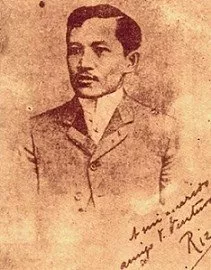
|
|
| (Dr. Jose P. Rizal) |
Early on, Jose manifested exceptional intelligence. He learned the alphabet at the age of three from his mother and was trained to do outdoor activities like riding horses. Father Leoncio Lopez influenced him to exude character that held high respect for the rights of others. At the age of nine, his parents sent him to study Biñan in the school of Don Justiniano Aquino Cruz, who, after a few months, reported to his parents that he had nothing more to learn in school. Jose excelled in academics and in physical activities.
Jose was allowed to study in Manila at the prodding of his brother, Paciano. By this time, he was already using the second family name, Rizal, in order to avoid complications in his studies, which the Mercado family name used by his brother Paciano could bring on him. His brother Paciano had earned the ire of the Spanish friars because of his relationship with Father Jose Burgos. Jose passed the entrance examinations at Colegio de San Juan de Letran owned by the Dominicans but he chose to study at Ateneo Municipal after learning that Dominican friars in Calamba were pursuing a court case against his mother. In 1872, he was admitted at the Ateneo through the help of Dr. Manuel Xeres Burgos, a nephew of Fr. Jose Burgos, and a close friend of Paciano. Burgos was able to convince Father Magin Fernando to admit Rizal at Ateneo.
On March 14, 1877, Jose obtained his Bachelor of Arts degree at Ateneo Municipal with high honors for excelling in academics. It was during his student days in Ateneo that his extreme giftedness in poetry, writing, painting and sculpture became known. One of the masterpieces he did at Ateneo was a sculpture of the statue of the sacred heart of Jesus and some of his literary works have won prizes like: Felicitacion, Por La Educacion Recibe Lustre la Patria, Un Recuerdo a mi pueblo, and El heroismo de colon.
In 1878, Jose studied Medicine, and Philosophy and Letters at the University of Santo Tomas and at the same time pursued a course in surveying at the Ateneo. Alongside with his academic studies at UST, Rizal actively participated in literary activities. He won first prize for his poem "A La Juventud Filipina" (To the Filipino Youth) in the literary contest sponsored by the Liceo Literario Artistico. Because he was a native, he experienced discrimination like when his entry "The Council of the Gods" which many spectators adjudged winner was awarded second to a work of a Spaniard.
In 1882, Jose sailed to Spain where he hoped to have better education and training, with the help of Paciano, his uncle Antonio Rivera and his friend Chenggoy (Jose Cecilio). It was Antonio Rivera who helped secure passage ticket for him to board the ship that would bring him to Singapore where he would take another ship to Spain.
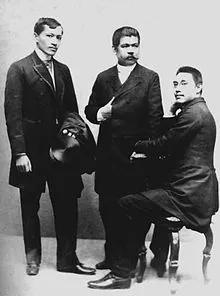
|
|
| (Left to right: Jose Rizal, Marcel del Pilar, and Mariano Ponce) |
One who had wielded influence among his countrymen abroad; Rizal’s speeches in gatherings of Filipino students were considered a gem. His speech, honoring Juan Luna and Felix R. Hidalgo, who both won the top prizes for their respective paintings during the Art Exposicion in Madrid in June 1884, saying: "Juan Luna and Felix R. Hidalgo are glories of Spain in the Philippines ..." was published in La Solidaridad.
Wanting to become an expert in the medical field, he trained under known specialists in Europe, like under Dr. Louis de Wecker, a famous ophthalmologist in Paris. He acquainted himself with other doctors like Otto Bayer, and Hans Meyer in Heidelberg, Germany. Alongside with his trainings and busy activities in the campaign for reforms was his pursuit in literature. He translated Schiller’s William Tell and Andersen’s Fairy Tales to Tagalog. He joined prestigious scientific societies in Europe.
Rizal’s committed campaign for reforms in the Philippines led him to write his two novels: the Noli Me Tangere, and El Filibusterismo. His first novel, partly written while he was staying in the home of a Protestant Minister, Pastor Karl Ullmer, in Wilhelmsfeld town in Heidelberg, Germany, was published in March 1887 through the financial assistance of his friend, Dr. Maximo Viola. His friend loaned him P300 to print the first 2000 copies. Both of his novels portrayed the pathetic situation of the Filipinos in the hands of the Spanish authorities and the influential Religious corporations. Copies of the novels were smuggled into the country since the Spanish authorities banned them.
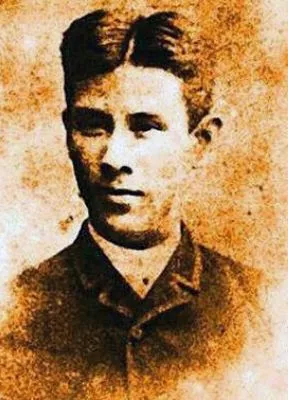
|
|
| (Maximo Viola) |
Since the publication of his first novel, Rizal's life in the Philippines became different. The Spanish friars who declared Noli me Tangere, impious, heretic, scandalous to the Catholic Church and injurious to the government, hated him. Thus, the liberal-minded Spanish Governor-General Emilio Terrero, concerned for his safety advised him to leave.
On February 3, 1888, Rizal left Manila. He sailed to Hong Kong, where he met Jose Ma. Basa. From Macao, he sailed to Japan, the United States, and in England. In Japan, the Spanish government offered Rizal a job as interpreter but he chose to be on his own. After staying for almost two months in Japan where he learned about Japanese arts, language and culture, he sailed to America. He left Japan on February 28, 1888 aboard the SS Belgic. He arrived in San Francisco on April 18, 1888, lodged at the Palace Hotel and then took a transcontinental train to the US East Coast via Chicago and the Niagara Falls in Lake Ontario. He stayed at the Fifth Avenue Hotel in New York for a while and sailed for England aboard the SS City of Rome, arriving at the Liverpool on May 24, 1888.
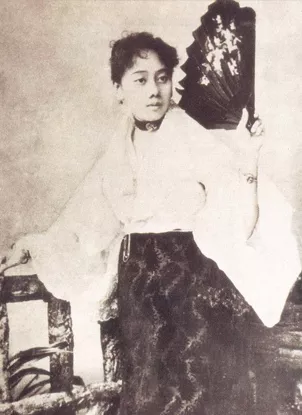
|
|
| (Leonor Rivera) | |
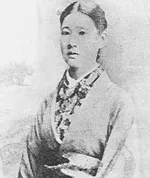
|
|
| (Beautiful Japanese, O-sei-san) | |
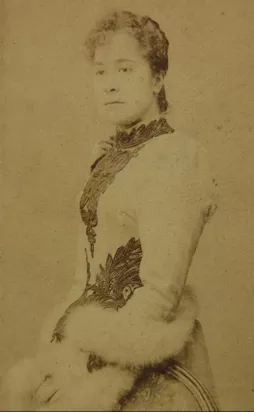
|
|
| (Frenchwoman Nellie Bousted one of Rizal's love) |
He Spoke Spanish, French, German, English, Dutch, Greek, Latin and Tagalog. He had knowledge of Ilocano, Visayan, Russian, Sanskrit, Arabic, Swedish, Hebrew, Malayan, Chinese, Japanese, Portuguese and Italian.
While in London, Rizal copied Antonio Morga’s Sucesos de las Islas Filipina, published in 1609, which he planned to annotate. It was during this work that he became acquainted with Dr. Reinhold Rost, a librarian and editor of Trubner’s Record. Rizal busied himself with other works while in England, he wrote the "Vision of Father Rodriguez" and "Letter to the Young Women of Malolos", both published in 1889.
In 1889, Rizal was in Paris where he published Morga's book with his annotations, founded Indios Bravos and witnessed the International Exposition. On January 18, 1890, he moved to Belgium where he became close with Jose Albert and Jose Alejandrino. Later, Albert would receive honor for his contributions in the medical field while Alejandrino would be remembered for fighting during the revolution against Spain and America. In Belgium, Rizal lived in poverty. The printing of his second novel, El Filibusterismo, a sequel of Noli Me Tangere, was stopped because of financial constraints until Valentin Ventura, a rich compatriot, came to his aid. Thus the book came out of the press on September 18, 1891.
Depressing news reached him from home. His sweetheart Leonor Rivera married Engineer Kipping; his folks were ejected en masse from Calamba; and the Spanish officials who were sympathetic to the reform movement turned hostile. He took his vacation at Biarritz at the invitation of the Bousteds. While there, Nellie Bousted proved to be a balm for his wounded feelings. Later, he left for Paris then went to Marseilles and boarded the SS Melbourne for Hong Kong. With his dwindling funds, he received money for his passage ticket sent to him by Jose Ma. Basa, a rich Filipino merchant who was living in exile in the British colony.
He arrived in Hong Kong on November 20, 1891. There, his family, ejected from their lands in Calamba, joined him through the financial help extended by his compatriots led by Jose Anacleto Ramos (Ishikawa). He practiced medicine to earn a living and at the same time, continued to support the campaign for reforms and to look for ways that could better the lives of the Filipinos. He proposed that a Filipino colony to accommodate Filipinos ousted from their lands in the Philippines be established. With funding from his friends, he went to Borneo aboard the SS Memnon. The British authorities were already agreeable to a 950-year lease of the proposed colony in Borneo but the Spanish Governor General Emilio Despujol refused to allow the Filipinos to migrate in North Borneo.
On June 26, 1892, he arrived in Manila with his sister Lucia aboard the SS Don Juan. Few days after, on July 3, he founded the Liga Filipina in the house of Doroteo Ongjunco on Ilaya Street in Tondo, Manila. The association was aimed to unite the Filipinos and for them to help each other in times of need, and to encourage them to be educated and trained in agriculture. The association was, however, short lived for after a few days of its founding, Rizal was arrested on flimsy charges. One of which was the leaflet entitled Pobres Frailes, a sarcastic allusion to the friars found on his baggage when he arrived from Hong Kong.
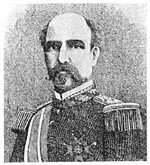
|
|
| (Eulogio Despujol) |
On July 17, 1892, Rizal was deported to Dapitan under the watchful eye of Ricardo Carnicero, the military commandant of Dapitan. One who never allowed time to be spent idly, Rizal busied himself with activities that were also beneficial to others. He established a clinic, a school, and constructed a water system. He bought tracts of land from his lottery winning and developed it into a farm. Loneliness impelled him to write Mi Retiro but reflected the strength of his spirit when he composed the hymn "Talisay".
He corresponded unceasingly with Ferdinand Blumentritt and other scientists he met abroad. He gathered specimens of plants and insects and sent them to his scientists friends abroad. His fame as an eye specialist lured patients to visit him in Dapitan. Among the most important was Engineer George Tauffer, who arrived with his foster daughter, Josephine Bracken. Soon, Josephine became his wife. Having inspired the revolutionary spirit of the Filipinos, Rizal was visited by Pio Valenzuela, an aid of Bonifacio to get his word about an armed uprising against the Spaniards. He was also offered help for his escape but he refused.
On July 31, 1896, Rizal sailed to Manila with Josephine, his sister Narcisa and other relatives after the Spanish government took his offer as doctor for the Spanish soldiers fighting against the rebel forces of Jose Marti in Cuba. Upon reaching Manila, Rizal was informed that his boat to Cuba had already sailed, thus, he was transferred to the Castilla then anchored in Cavite until another boat, the Isla de Panay took him to Singapore. There, Pedro Roxas urged him to leave the boat, assuring him his safety in the British Territory but he refused.
On September 30, 1896, while the Isla de Panay was sailing through the Middle East, the ship captain received orders of Rizal’s arrest on charges that he had a hand in the revolution that was already raging in the Philippines. Thus, Rizal arrived in Barcelona as a prisoner and was briefly detained at the Montjuich Penitentiary. The following day, he was shipped back to the Philippines on the boat Colon. His friends tried to rescue him by court proceedings. While the boat was in Singapore, Dr. Antonio Ma. Regidor and some British lawyers who, through Lord Hugh Fort, filed writ of habeas corpus in the Supreme Court of the Straits Settlements for his release on the ground that he was illegally detained. But Judge Lionel Cox ruled that the Colon was a troopship flying the Spanish Flag and that he was a Spanish subject. Therefore his case was not under British jurisdiction.
On November 3, 1896, the famous prisoner arrived in Manila and was imprisoned at Fort Santiago. On November 26, he was tried by the military court on the charges of rebellion, sedition and illegal organization of societies presided by Judge Advocate Enrique Alcocer at the Cuartel de España. Rizal’s defense counsel was Lieutenant Luis Taviel de Andrade, whose efforts to save him failed. He was meted the death penalty.
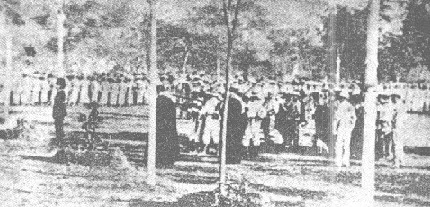
|
|
| (Execution of Dr. Jose Rizal at Bagumbayan (A reproduction of an original photo taken during the execution of Dr. Jose Rizal)) |
On December 30, 1896, he was marched out of Fort Santiago toward Bagumbayan Field. With him were Fathers March and Villaclara and his legal counsel, Luis Taviel de Andrade. Before he was shot, he handed his belt to his nephew, Mauricio. The Spanish doctor, Ruiz y Castillo, felt his pulse and found it normal. Rizal faced the Filipino soldiers of the firing squad guarded by the Spanish soldiers. Volleys were fired. He fell but with a great effort, he turned his back and fell facing his executioners.
Two years after, on August 17, 1898, his sisters exhumed his remains buried at the Paco Cemetery and kept it at their residence in Binondo before it was finally rested at the monument in his honor at Luneta, now Rizal Park.
References:(Bantug, Asuncion Lopez. Lolo Jose An Intimate Portrait of Rizal. 1982. Coates, Austin. Rizal Philippine Nationalist and Martyr. Manila: Solidaridad Pub. House, 1992.
Eminent Filipinos. Manila: National Historical Commission. 1970
Fernandez, Jose Baron. Jose Rizal Filipino Doctor and Patriot. Manila: Rex Printing Co., 1980.
Zaide, Gregorio. Great Filipinos in History. Manila: Verde Bookstore, 1970.) all via The Philippine Historical Commission

